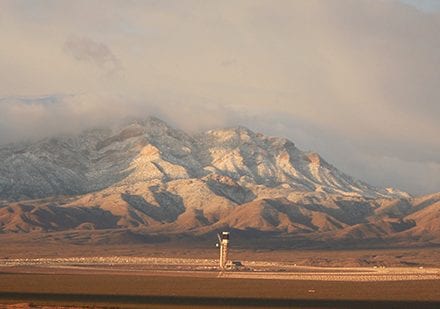After driving several hours along Interstate 15 through the desolate and ancient land formations of the Mojave Desert, and after rising over a large summit, you are suddenly presented with a glimpse of what many say is the future of electricity generation.
The 392MW Ivanpah solar tower power station is the biggest concentrated solar thermal project in the world. It is also the most visually arresting. It features three huge towers, each 150m tall, surrounded by huge fields of mirrors that will focus the sun’s energy on a receiver located at the top of the tower. Water is boiled to create steam that then drives the turbines.
It’s solar generation at a massive scale, made more impressive by its surroundings. Even though it spreads over so many hectares, its size pales against the grandeur of the stunning Mojave landscape.
Ivanpah is not the only solar power station of large-scale being built in this art of the world. To the north, across the state border in Nevada, a 110MW solar tower with storage facility is being built by SolarReserve.
To the west, in the heart of California’s “high desert”, First Solar is nearing completion of a 250MW AVSR solar PV project near Lancaster, while down the road SunPower has begun construction of a 579MW solar PV plant of their own.
A little further north, the tables are turned as SunPower puts the finishing touches to its 250MW CVSR project, while First Solar is about to trump it with the 550MW Topaz solar PV project, which is half way through construction.
But even as these massive projects are nearing completion, the question is being asked: Does the future of solar really lie in more of these large scale projects? Even the owners of these huge projects are not so sure.
NRG, the largest owner of generation assets in the US, and part owner of the Ivanpah project, says it is uncertain about the future of such large scale projects, because they are hugely capital-intensive.
“These projects are massive, and even though the technology is proven it is very difficult to continually build these in the US, because there are limits to where these projects can be placed,” says Todd Michaels, the head of distributed generation for NRG.
“Utilities are fully procured out in the south-west where this technology most appropriate. You are seeing a move to push new solar projects into distribution network. That’s where our CEO David Crane is saying these projects are heading – into distributed energy in general and solar in particular.”
CEO SunPower Tom Werner is building two of these massive projects, but even he says he is not sure where the future lies, which is why he is having his company hedge his bets.
“We large scale utility, large and small distributed generation , and rooftop,” Werner told RenewEconomy is a recent interview. “We purposely straddle all three because we don’t know the answer to your question, to be honest.
“Here’s how we look at it. The beauty of solar is that it is easy to site, where there is sun. It’s quick to install, scaleable, and you can make it big or small. Those are huge advantages.
“So you can though utility problem on its head – you ask yourself, where do I have transmission, where do I have load, and then you can put put solar in it.
“If you think that way, you need all three. In Los Angeles, where there is load, it’s where the buildings are, there’s lots of roof space, and the distribution capacity argues for distributed generation. But for sure large scale ground mount is half the price, but you need the land. There will be different solutions for different environments.”
Werner says it is probable that distributed generation will disrupt the way utilities deliver energy. “The idea of hub and spoke of a large energy generation and transmitted to a bunch of customers is likely to be disrupted by solar DG,” he says, echoing comments by NRG’s Crane
“The economics have come down enough, so people are asking why don’t I just generate where I use it. The key is whether you need the wires or not. We are a few years away from that not being needed.”
“Our view is that both will exist in the long run, but distributed generation – I can quote big utilities exec who 3-4 years ago called it “loony”. But they are now investing.”
Werner’s point about distributed generation is borne out by recent developments, both here and in the US. The local utility in Palo Alto, in the heart of Silicon Valley, recently conducted an auction and awarded 80MW of solar projects for just US6.9c/kWh, which equates to around US10c/kWh after tax incentives.
In Australia, it will be interesting to see what takes off first. SunPower will likely be announcing some projects as it rolls out its “energy services” model with Diamond Energy. But it seems clear that many of the projects will be designed with local load needs in mind.
The Sunshine Coast council may have set the tone, with its announcement last week that it will build a 10MW solar farm to provide half of its energy needs.
That is just half way down the road to the sort of scenarios painted by NRG’s Crane and SunPower’s Werner. It’s unlikely that customers will not need the grid at all – barring some stunning developments in storage, but they are likely to need it a lot less than in the past.











